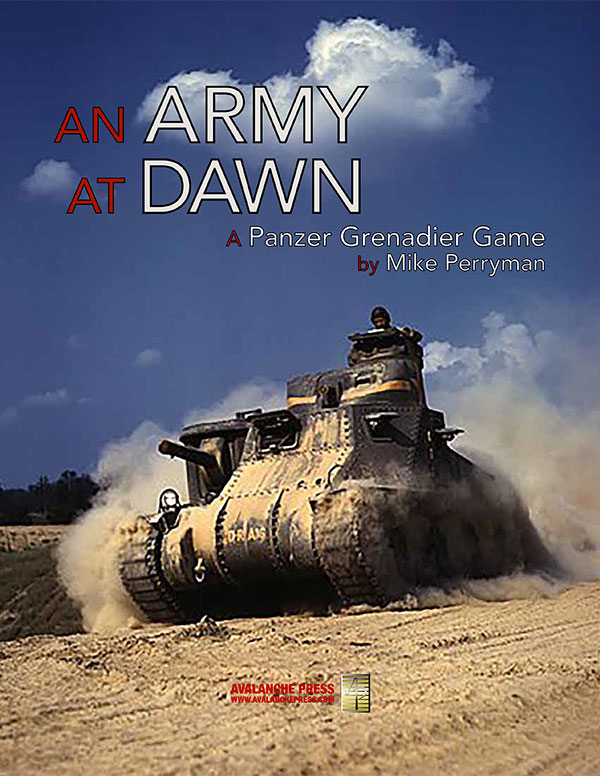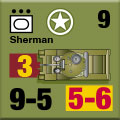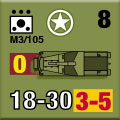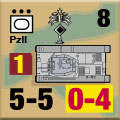| An Army at Dawn
Scenario Preview, Part Three
By Mike Bennighof, Ph.D.
June 2024
 I have this notion, that board wargames (like Panzer Grenadier) can be used as a vehicle to tell the story of a battle, campaign, or war, through their game scenarios. Each scenario in a Panzer Grenadier game is a whole game in itself, telling the story of a particular battle. You can play any of the scenarios in any order you like, but if you play them (or even just read them – we won’t tell) chapter by chapter, then the story unfolds before you. In this case, it’s the evolution of the American 1st Armored Division in the Tunisian campaign of 1942 and 1943. I have this notion, that board wargames (like Panzer Grenadier) can be used as a vehicle to tell the story of a battle, campaign, or war, through their game scenarios. Each scenario in a Panzer Grenadier game is a whole game in itself, telling the story of a particular battle. You can play any of the scenarios in any order you like, but if you play them (or even just read them – we won’t tell) chapter by chapter, then the story unfolds before you. In this case, it’s the evolution of the American 1st Armored Division in the Tunisian campaign of 1942 and 1943.
For its new Playbook edition, designer Mike Perryman has re-cast Panzer Grenadier: An Army at Dawn in this mold. Let’s have a look at the fourth chapter.
Chapter Four
The Learning Curve
 The first weeks of combat in Tunisia saw the American 1st Armored Division’s Combat Command B gain a great deal of valuable experience, but at a terrible cost in lives. While dealing with fantastically inappropriate doctrine and badly out-matched equipment, division commander Orlando Ward also faced the intractable problem of a ragingly incompetent superior, Lloyd Fredendall of II Corps. The first weeks of combat in Tunisia saw the American 1st Armored Division’s Combat Command B gain a great deal of valuable experience, but at a terrible cost in lives. While dealing with fantastically inappropriate doctrine and badly out-matched equipment, division commander Orlando Ward also faced the intractable problem of a ragingly incompetent superior, Lloyd Fredendall of II Corps.
Fredendall would not allow Ward to deploy his division as a whole formation, detaching sub-units as infantry support and even to British formations. The corps commander often communicated directly with Ward’s subordinates, by-passing 1st Armored Division headquarters. Fredendall responded to Ward’s protests by freezing the division commander out of operational meetings and refusing to speak to him.
Army Chief of Staff George C. Marshall had marked Fredendall for greatness before the war. Marshall’s patronage made Fredendall nearly impossible to fire, had theater commander Dwight Eisenhower had the impulse to do so. And Eisenhower showed no signs that Fredendall’s job lay in jeopardy, even as the failures, and the casualties, piled up. In such a command environment, it would be the front-line soldiers who suffered. And they did, with 1st Armored Division only slowly advancing along its learning curve.
Scenario Nine
Dejebel el Guessa
6 December 1942
 The British infantry had suffered severe losses defending Tebourba. Combat Command B from the 1st Armored Division took their place while the Tommies pulled back for rest and refitting. The U.S. Army’s official history states that CCB was “rankled by their recent setbacks” under British command (neatly blaming British First Army commander Kenneth Anderson rather than Fredendall), and sure they would do better under American leadership. Five new Sherman tanks bolstered their confidence as part of the replacements for the numerous older Lee medium tanks already lost. Enemy flares illuminated their positions well before dawn, signaling to observant officers that their confidence would soon be tested. The British infantry had suffered severe losses defending Tebourba. Combat Command B from the 1st Armored Division took their place while the Tommies pulled back for rest and refitting. The U.S. Army’s official history states that CCB was “rankled by their recent setbacks” under British command (neatly blaming British First Army commander Kenneth Anderson rather than Fredendall), and sure they would do better under American leadership. Five new Sherman tanks bolstered their confidence as part of the replacements for the numerous older Lee medium tanks already lost. Enemy flares illuminated their positions well before dawn, signaling to observant officers that their confidence would soon be tested.
Conclusion
Combat Command B’s confidence quickly slipped away and confusion reigned. It took the paratroopers less than half an hour to turn the American flank. This left Battery C of the 27th Armored Field Artillery Battalion exposed. They engaged the panzers with their halftrack-mounted howitzers in an uneven duel for two hours waiting for rescue, radioing “For Christ’s sake . . . please, please send help!” Unfortunately, the medium tanks had rolled forward four hours before but foundered in the terrain, not making the six miles to the battlefield for another hour. By that time Battery C had ceased to exist. When the tanks showed up, they split into two forces and charged through the valley at full speed with no reconnaissance. Fifteen minutes later all five of the confidence-building Shermans and thirteen M3 Lees burned fiercely as German medics tried to save the survivors. Later, another American attack and heavy rain stabilized the situation but the Americans sustained substantial losses.
Notes
The Germans are on the attack, with a balanced force that carries a slight edge in numbers and a serious edge in morale. The Americans do get substantial tank reinforcements, and will likely need them to counter-attack and restore their positions.
Scenario Ten
Bordj Toum
10 December 1942
 Heavy rains over the preceding several days had rendered the battlefield too muddy for combat. The commander of 10th Panzer Division, Lt. Gen. Wolfgang Fischer, deemed the ground finally satisfactory for combat operations but he knew that mechanized forces might still be in trouble if forced off the roads. With that in mind, he ordered an attack on both sides of the Medierda River. The northern prong advanced rapidly along Highway 50 to just outside the town of Bordj Toum where a minefield hampered their movement. Heavy rains over the preceding several days had rendered the battlefield too muddy for combat. The commander of 10th Panzer Division, Lt. Gen. Wolfgang Fischer, deemed the ground finally satisfactory for combat operations but he knew that mechanized forces might still be in trouble if forced off the roads. With that in mind, he ordered an attack on both sides of the Medierda River. The northern prong advanced rapidly along Highway 50 to just outside the town of Bordj Toum where a minefield hampered their movement.
Conclusion
The Americans fought the Germans to a draw, protecting the bridgehead over the Medierda River and securing Medjez el Bab from the north. While successful, committing the medium tanks to the defense here took them out of position to support the desperate fighting going on to the south.
Notes
Another German attack, with some pretty substantial objectives but a large superiority of force will help them achieve it. The American defenders are weak, but thick mud (yes, mud in the desert) will slow down the German attack.
Scenario Eleven
Panic at Djebel Bou Aoukaz
10 December 1942
 As part of a concentrated effort to take Medjez el Bab on 10 December, the 10th Panzer Division attacked with strong forces on both sides of the Medierda River. Along the southern bank the Germans sought to drive the Americans from Djebel Bou Aoukaz as their first objective. As the Americans’ closest help sat over eight miles away, the Germans’ assignment looked easy on paper. As part of a concentrated effort to take Medjez el Bab on 10 December, the 10th Panzer Division attacked with strong forces on both sides of the Medierda River. Along the southern bank the Germans sought to drive the Americans from Djebel Bou Aoukaz as their first objective. As the Americans’ closest help sat over eight miles away, the Germans’ assignment looked easy on paper.
Conclusion
The Americans took the best the Germans could throw at them and retained the hill. They were learning a few lessons, but not enough of them yet. That night the Americans began to pull back from the Djebel Bou Aoukaz, and left behind dozens of guns, tanks and vehicles stuck in the mud thanks to poor maintenance and a complete lack of heavy tractors to pull mired vehicles free, despite repeated requests for them.
Notes
This time the Americans have a more adequate force to defend a much narrower front, which should help their cause. And there’s that nasty mud on the ground again, but no American tanks or air power and very little artillery.
And that’s it for Chapter Four. Next time, we dive into Chapter Five.
You can order An Army at Dawn right here.
Big Red Package
An Army at Dawn
Big Red One
Retail Price: $92.98
Package Price: $85
Gold Club Price: $68
You can order the Big Red Package right here.
Sign up for our newsletter right here. Your info will never be sold or transferred; we'll just use it to update you on new games and new offers.
Mike Bennighof is president of Avalanche Press and holds a doctorate in history from Emory University. A Fulbright Scholar and NASA Journalist in Space finalist, he has published a great many books, games and articles on historical subjects; people are saying that some of them are actually good.
He lives in Birmingham, Alabama with his wife, three children, and new puppy. He misses his lizard-hunting Iron Dog, Leopold.
Want to keep Daily Content free of third-party ads? You can send us some love (and cash) through this link right here.
|
